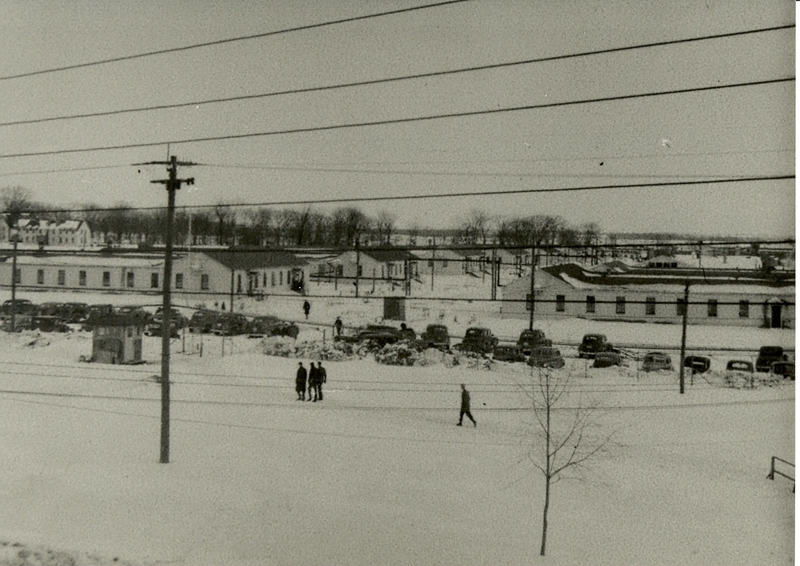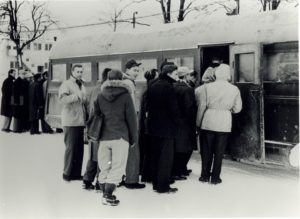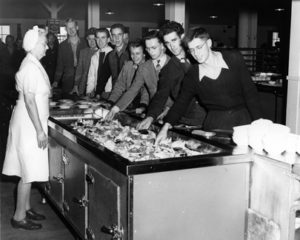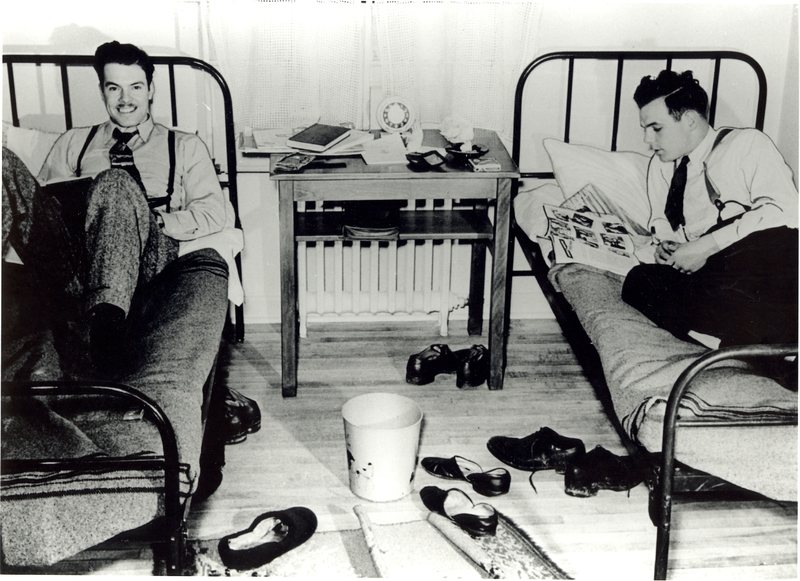Remembering Ajax: Innis and engineers’ special connection
In January of 1946, less than a year after the conclusion of the World War II, 1400 new University of Toronto students started their studies in Ajax, Ontario, on the former site of the largest munitions plant in the Commonwealth. Far from the university’s St. George campus, some 5500 engineering and architecture “jaxmen” called the 450 acre campus home from 1946-1949. While the site claims to be the location on which the Lady Godiva Memorial Band was incorporated, and where notable alumni including Peter Monk and John Bahen studied, little evidence of the former campus remains. Besides a memorial stone located outside of the Galbraith building, only the top two floors of Innis Residence’s south tower, christened ‘Ajax House,’ continue as a testament to this unique period in U of T’s history.

Mindful of the great number of servicemen returning from the front following the war, and with a desire to develop Canadian engineering, the federal government worked with the university to expand its relatively small Faculty of Applied Science in 1945. While the university was tasked to find space for the sizeable influx of students, the government did its part to ensure enrolment by offering former servicemen free tuition, as well as a $60 a month stipend if they took up engineering at U of T.
When the university first acquired the site, it was so contaminated with gun powder that a “spark could throw the whole place high.” Indeed, the plant which had employed 9000 workers during the war, filling some 40 million shells between 1941-1945, needed substantial renovations before students moved in January of ‘46. With considerable support from the government, in less than six months the site was cleaned up and equipped with drafting rooms, dozens of electrical, physical, chemical and geological laboratories, 2200 residence rooms, and a dining hall. The site also contained a post office, library, hospital, and a miniature ‘Hart House.’ Indeed, as one former professor remarked, the campus was like “a small town run by the university.”

In 1946, with 55% of first year students veterans, the campus began its bizarre social experiment in which battle worn soldiers and freshmen not long out of high school shared meals, classrooms, and dorms. Many veterans came to call the campus’ “barrack revival” style architecture a halfway house, between the front and returning to Canadian society. University documents indicate that some veterans were assigned to their own classrooms to prevent academic embarrassment in front of the younger students, and many who were married faced serious challenges with commuting and caring for their young children. But, overall, this blending of experiences seems to have been a success, with veterans and freshmen alike fondly remembering their time in Ajax.
Perhaps out of a combination of its demographics and geography, Ajax developed its own set of traditions, unique to those established on the St. George campus. For one thing, the practice of initiating freshmen, common at the university at the time, was taboo at Ajax. As the Dean of Students noted, “there is a great number of you here and hence [you are] capable of doing rather senseless damage” with initiation activities. Instead, Ajax rites of passage included participating in grape bombardments, and riding the campus “metro system” between classes, which comprised of a large green bus, dubbed “green dragons”. A popular pastime recorded in numerous alumni accounts was to call up the local Bell Telephone operating centre and invite over the company’s female operators for parties. With a live band and contraband alcohol, these parties were quintessential to life at Ajax. According to some accounts, at one party – to make their female guests more comfortable – jaxmen designated a bathroom for the girls and decorated it with goldfish-filled urinals.
Alumnus Chris Hinde also recounts another story worthy of a Hollywood screenplay. In an anecdote labelled “The Great Ajax Tombstone Caper,” Hinde describes how representatives of the Engineering Society from St. George campus arrived in Ajax by car one evening to task the isolated campus with the construction of a tombstone. A team from the class of 5T1 then ‘acquired’ a bag of cement from a local housing development, and crafted, and delivered, a tombstone to St. George campus to mark the Varsity Blues final ‘burying’ of the Western Mustang’s on the football field.

For a campus “removed from civilization,” and with classrooms spread out wide enough so that an explosion in one would leave the others unharmed, the Ajax period was marked with success. With normalizing enrolment in 1949, the campus was closed, and first and second years studying in Ajax moved downtown to complete their degrees. At the campus’ closing, students were presented with the crest of HMS Ajax, the naval vessel for which the town shared its name, as a token of their cooperation and loyalty to the post-war project. Dean of Students, R.H. Perry, in his final Dean and Supervisor of Residences Report also thanked students for being a good “public” and for “playing ball.”
Forty-five years after the Ajax campus closed its doors, the Ajax Remembered Committee, headed by Don King (5T0) succeeded in establishing a physical reminder of residence life at Ajax on the university’s modern campus. Billed as a perpetuation of the spirit engendered at Ajax, prior to opening of Innis Residence in 1994, a substantial donation drive was established to raise funds for a rather unique memorial to the former campus. With the enthusiastic support of then Innis Principal, John Browne, and Dean of Residence, Garry Spencer, Ajax alumni donated some $400,000 to the college to help pay for the top two stories of the south tower of Innis Residence. In return for their generosity, numerous rooms on the 6th and 7th floors of the south tower remain named after those alumni who donated more than $7000 to the cause. The music room, located in Ajax House, is also home to photographs and stories about the Ajax experience, and a plaque telling the story of the former campus hangs in the lobby. The assured space for engineers in the largely Arts and Science dominated residence was also an outcome the committee’s relationship with Innis College.
Today, with 50 engineering students living in Innis and participating in the college’s lively student life community, the university’s living memorial to the veterans and students who were trained in Ajax is thriving. Not only do the traditions of Ajax campus live on in name, but also in the college’s mirroring of the former campus’ blended community of veterans and first year students, captured in Innis Residence’s commitment to combining students from engineering with those studying in other disciplines.
With thanks to Innis College’s Dean of Students and Residence, Steve Masse, for inspiring this piece, and to Ben Westrate for providing access to the college’s archives for research. Featured image courtesy of U of T Archives.
